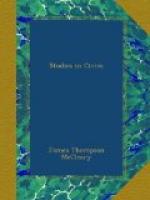Three “lists” of the vote for president and three for vice-president are prepared, and “signed, certified and sealed.” One pair of these lists is sent by mail and another by special messenger. The third is deposited with the judge of the United States District Court in whose district the electors meet, to be called for if necessary. The purpose of these precautions is to make sure that the vote of the state may not be lost, but shall without fail reach the president of the senate.
Clause 4.—Times of These Elections.
The congress may determine the time of choosing the electors,[1] and the day on which they shall give their votes;[2] which day shall be the same throughout the United States.[3]
[1] The day designated by congress is the first Tuesday after the first Monday in November. The election always comes in “leap year.”
[2] The electors meet and vote on the second Monday in January.
[3] This provision was designed, first, to prevent fraud in voting; and second to leave each state free to act as it thought best in the matter of persons for the offices, unbiased by the probability of success or failure which would be shown if the elections occurred on different days in different states.
It may be desirable to know in this connection that:
The president of the senate sends for missing votes, if there be any, on the fourth Monday in January.
The counting of votes is begun on the second Wednesday in February and continued until the count is finished. (See page 334.)
In case the electors have not given any one a majority for the presidency, the house proceeds at once to elect. In a similar case the senate proceeds at once to choose a vice-president.
The provisions of the continental congress for the first election were:
1. Electors to be chosen, first Wednesday in January, 1789.
2. Electors to vote, first Wednesday in February.
3. The presidential term to commence first Wednesday in March. The first Wednesday in March in 1789 was the fourth day of the month, and on that day the presidential terms have continued to begin.
Clause 5.—Qualifications of President and Vice-President.
No person except a natural born citizen,[1] or a citizen of the United States at the time of the adoption of this constitution,[2] shall be eligible to the office of president; neither shall any person be eligible to that office, who shall not have attained to the age of thirty-five years,[3] and been fourteen years a resident within the United States.[4]_
[1] The importance of the office is such as, in the opinion of the framers of the constitution, to necessitate this requirement. And it does not seem unjust to make this limitation.
[2] This exception was made from a sense of gratitude to many distinguished persons, who, though not native citizens, had placed their lives and fortunes at the service of this country during the revolution, and who had already become citizens of the young republic. This provision is now, of course, obsolete.




